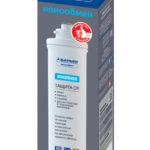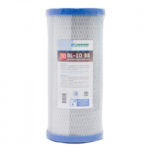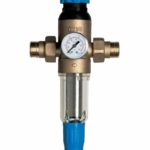The water from the central water supply system or well contains impurities that are harmful to human health. Chemical analysis reveals heavy metals, organic compounds, large amounts of chlorine, pathogenic microorganisms. The multistage cold water filter retains suspended solids and solutes. Depending on the device of the module, the liquid has a different degree of purification. Information about the types of filters and how they work will help you choose the best option.
Purpose and application of filters for water purification
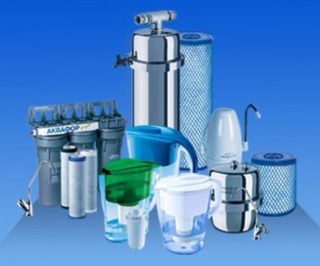
Filters are devices that purify water from undissolved sediment, chemical and organic impurities, heavy metals, chlorine, bacteria. Exceeding sanitary standards for these parameters seriously harms health. Hard water with calcium and magnesium causes limescale to build up on heating elements in household appliances. This shortens their service life. Water that has been trained is supplied to city apartments, it needs additional treatment. The liquid from the well requires an installation that can cope with a set of tasks:
- removal of turbidity and color;
- getting rid of chemical impurities;
- elimination of microorganisms.
Purification modules can be installed separately on a kitchen tap with drinking water or on a common line in an apartment. Devices for processing large volumes of liquid must have a long service life. Their functions:
- softening;
- removal of chlorine and its compounds;
- deferrization;
- improved taste.
By design, filtering devices are divided into several groups:
- household;
- trunk;
- industrial;
- tourist.
The use of filters for hot water relieves boilers, boilers, washing machines from the appearance of scale during the heating process.
Types of filters, device and principle of operation
Household water filters are classified according to the method and degree of purification. The process of processing a liquid to acceptable parameters of its composition occurs by various methods.
Mechanical
The method consists in capturing and settling suspended particles. Mechanical filters are installed in front of meters, pumps, plumbing fixtures. The filter element is a metal mesh or polypropylene fiber. The module can be completed with a pressure gauge to control the pressure in the pipeline. A common model of the device is a stainless steel or brass sump.
Sorption
The process of removing harmful impurities occurs due to the sorption properties of the backfill. Activated carbon is located inside the cartridge or column. The porous material absorbs dissolved chemicals (oil products, pesticides), chlorine, organic compounds. It neutralizes odors, unpleasant taste, part of microorganisms. The backfill is restored by flushing. Sorption filters are produced in the form of columns, used independently, and cartridges for multistage flow-through cleaning units. Carbon cartridges are often used in filter jugs.
Ion exchange
The method is the replacement of calcium and magnesium ions dissolved in water with sodium ions. A chemical reaction takes place in the granular resin bed. It is an inorganic porous material. To improve water treatment, special reagents are added to it.After softening, no scale forms on the heating elements of the devices, less detergents are consumed during washing. The backfill is restored with a solution of sodium chloride or citric acid.
Ion-exchange filters are used in a complex of stationary installations.
Reverse osmosis
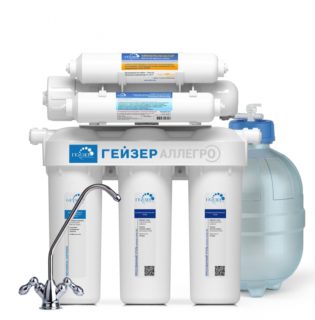
The use of reverse osmosis is considered to be the most effective method of water purification. It removes all contaminants. Liquid processing takes place at the molecular level. Only water and oxygen molecules pass through the semipermeable membrane. All impurities remain on the outside of the barrier and are flushed down the drain. The liquid at the outlet is deprived of salts, bacteria, chemical impurities. High demineralization is a disadvantage of the methods.
The reverse osmosis system consists of three or five stages of purification. Its components, in addition to a thin-film membrane, are carbon and mechanical filters.
Electric
Electrical methods include ozonation and the use of UV radiation. Ozone purification technology uses the oxidizing properties of gas. It removes chlorine compounds, heavy metals, oil products and iron. Ozone disinfects liquid by killing bacteria and viruses.
The main purpose of the UV lamp is to disinfect water. Radiation quickly destroys microorganisms. The device does not affect the taste of the liquid.
Filters are divided into two categories according to the degree of removal of impurities.
Rough cleaning
Prefilters or mechanical cleaning devices are of various designs:
- Mesh - the main element is stainless steel mesh with cells of 50-200 microns. The unit is flushed manually or semi-automatically.
- Magnetic - in addition to the mesh element, magnetic inserts are installed that trap iron particles.
- Disc - the design consists of plastic discs with fine holes 5-200 microns. The modules are easily washed, used in everyday life and at work.
- Cartridge type - products include a flask, a cartridge and a connection socket. The cartridge is a hollow cylinder wrapped in polypropylene threads. After the resource is used up, it must be replaced.
All coarse cleaners retain undissolved particles. The size of the captured suspension depends on the cell parameters. After the pre-filters, the water is not ready to be consumed raw.
Fine cleaning
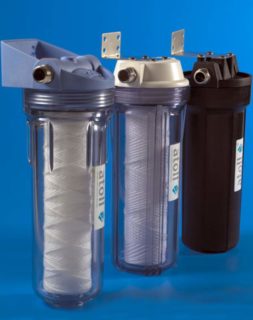
Removal of heavy metals, dissolved chemicals, chlorine, various salts and microorganisms is possible with fine household filters for drinking water. These include:
- iron removers - columns with mineral or synthetic backfill that binds iron;
- carbon (sorption) - cartridges with activated carbon absorb chemical compounds, chlorine, hydrogen sulfide;
- ion exchange - resin-based softeners;
- reverse osmosis systems - the main cleaning takes place through a membrane with pores of 0.0001 microns.
The liquid is purified to the norms that allow you to use water without harm to health. These are stationary units located in the kitchen. They provide two to five stages of liquid purification. The productivity of the units is up to 3 l / min., The resource is up to 15,000 liters.
Multistage membrane modules are equipped with a storage tank.
How to choose a filter
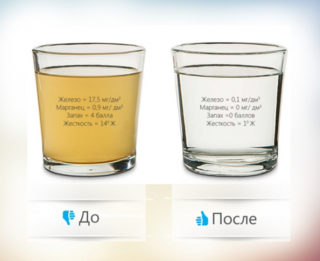
To find a suitable filtration system, you need to find out the chemical composition of the water. For stand-alone wells, this is the standard procedure. It is not recommended to consume liquid from the well before it is carried out. There are fewer dangerous impurities in a centralized water supply system, chlorine neutralizes them, but its compounds are also harmful to health. During the examination, the following is checked:
- color (appears due to mineral sediment);
- the presence of heavy metals;
- rigidity;
- the amount of iron;
- chlorine compounds;
- the presence of microorganisms;
- chemical impurities, etc.
After receiving information about the parameters of the liquid, you can proceed with the selection of an installation that will lead them to sanitary standards. It is important to consider the characteristics of the filter itself:
- Performance. This indicator reports on the volume of liquid that the installation is able to clean and pass per unit of time. The lowest rates are for the reverse osmosis system. It is equipped with a tank in which a supply of purified water is collected. Also, the low productivity of jugs with a cartridge.
- Resource. Parameter showing the maximum volume of liquid for which the module is designed. Before buying, you need to calculate the average water consumption in the house. The drinking rate for a person is up to 2 liters per day. To it is added another 1 liter for cooking. The number is multiplied by the number of people. It is advisable to increase the result by 2-3 times for the reserve. Comparing the two values, the appropriate option is selected. When installing a multi-stage cleaning, the characteristics of each cartridge in the system are studied.
- Cost and consumables. The affordable price of the filtering device is only the first stage of expenses. You need to find out the cost of cartridges and the frequency of their replacement.
The price for fine water filters is much higher than for coarse filtration modules. If the liquid is of good quality, there is no need to spend money on an expensive installation. Increased hardness, chlorine, hydrogen sulfide and iron can be removed only by sorption-type modules and reverse osmosis membranes.
Installation rules
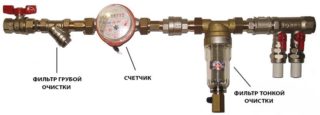
When installing the filter system, the coarse (mechanical) cleaning module is always installed first. It retains admixtures of sand, silt, clay, small stones and other debris. The preliminary removal of suspended solids extends the service life of the fine filters. Mud collectors are installed on the hot and cold water supply mains. By the type of tie-in, they are coupling and flanged. Trapped particles accumulate in the sieve glass of the sump. The unit is installed on horizontal sections of the pipeline strictly in the direction of the arrow on the body.
Stationary filters are placed under the sink. They are completed with parts for connection to water supply and sewerage systems. Installation work is carried out after shutting off the taps and discharging liquid from the pipes. The assembly and installation diagram is attached to the product, follow the instructions. The set includes a tap, for which a hole is drilled in the sink. You will need to install a tee on the cold water pipe. The filtering structure is connected to it with a flexible hose. The second outlet, intended for treated water, is connected with a hose to the drinking tap. The drainage pipe is directed to the sewer. All joints are sealed with FUM tape.
Features of operation and maintenance
Most household filters can be installed and serviced by yourself. They have a certain service life, after which regeneration or replacement is required. This period is adjusted depending on the condition of the water. With minimal contamination, cartridges are changed less frequently. The signal for flushing the mechanical filters is the pressure drop in the pipeline.
Recommended replacement times are indicated on the cartridges:
- prefilters - 6 months;
- reverse osmosis membrane - 24-30 months;
- sorption - 12 months;
- ion exchange - with regular regeneration up to 5 years.
Many manufacturers make standardized cartridges. Products from different brands have the same dimensions and can be substituted for each other.
Filters cost
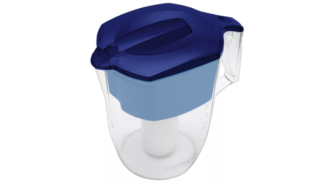
The price of cleaning modules depends on their purpose, technical characteristics and manufacturers. Budget options:
- Geyser jugs with a volume of 2.5-3.7 liters - 350-850 rubles;
- Pitchers Aquaphor Line - from 250 rubles;
- Geyser Euro faucet nozzle - 661 rubles;
- Filter attachment Aquaphor Modeon - 809 p.
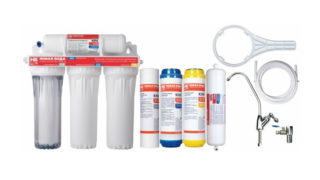
Multi-stage modules for washing, cleaning from iron, chlorine and heavy metals, depending on the model, cost from 1460 to 5800 rubles.Top manufacturers:
- Geyser Bio 311 with complex purification and mineralization - 3800-5100 rubles;
- Atoll U-31 STD - 6,100 rubles;
- Aquaphor Crystal with a resource of 8000 l - 2500 r.
The most expensive are reverse osmosis systems. For a unit with five degrees of cleaning, a storage tank and a crane, you will have to pay from 7050 to 30,000 rubles. Popular models:
- Aquaphor Osmo-Crystal 100-4M - RUB 8400;
- Atoll A-550 Patriot - 8500 rubles;
- Geyser Prestige-M with a 7 tap and a 12 liter tank - RUB 9,900;
- Angstra R 5-C –17240 RUB
The choice of filters depends on the characteristics of the water and the financial capabilities of consumers. Fine cleaning devices bring the parameters of the liquid to the parameters favorable to health. These include reverse osmosis systems and flow-through filters for washing. The processed water becomes soft and tasty.

